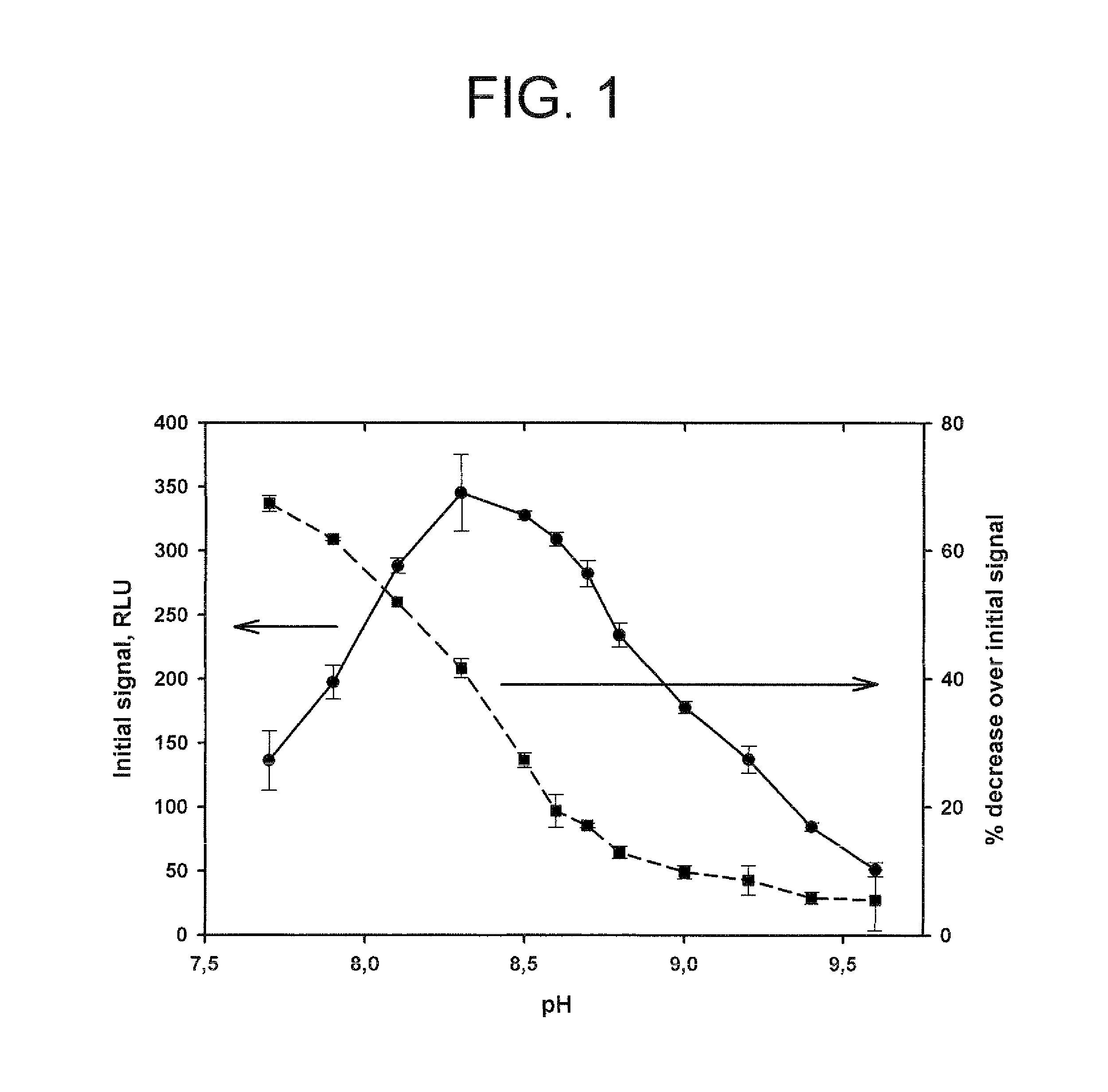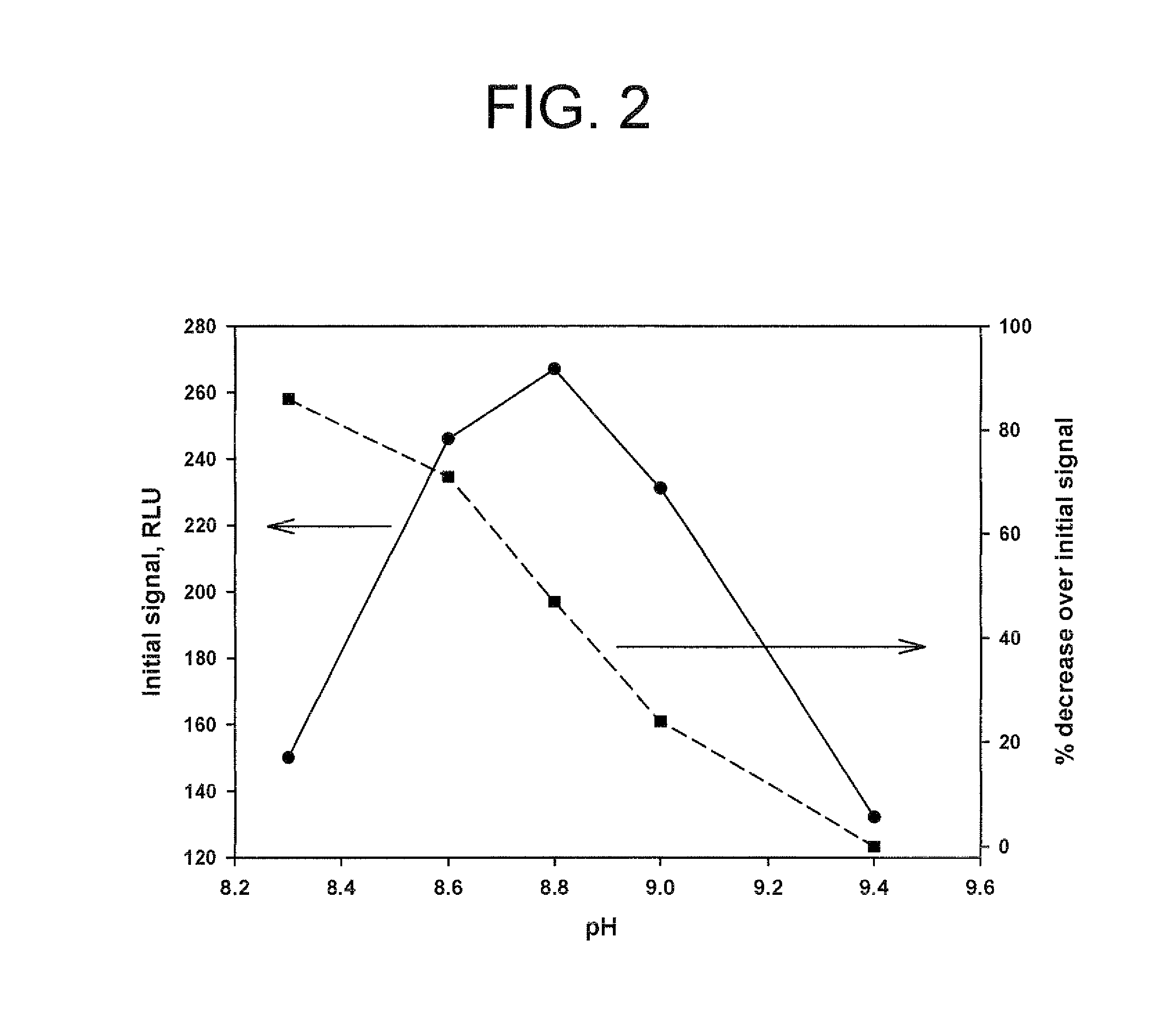Method for increasing and regulating light emission from a chemiluminescent reaction
a technology of chemiluminescent reaction and light emission, which is applied in the direction of biochemistry apparatus and processes, material testing goods, instruments, etc., can solve problems such as difficult regulation, and achieve the effect of increasing and regulating light emission
- Summary
- Abstract
- Description
- Claims
- Application Information
AI Technical Summary
Benefits of technology
Problems solved by technology
Method used
Image
Examples
example 1
pH dependence of imidazole on the luminol-peroxide-sodium 3-(phenothiazin-10-yl)propane-1-sulfonate-peroxidase reaction
[0043]A chemiluminescent substrate was prepared with the following composition:
[luminol sodium salt]=5 mM
[sodium perborate]=4 mM
[sodium 3-(phenothiazin-10-yl)propane-1-sulfonate]=3 mM
[imidazole]=10 mM
[0044]In 0.15 mM Tris Buffer, pH 9.0
[0045]A series of disposable polymethylmethacrylate cuvettes is prepared, each containing 2 mL of substrate solution. To each cuvette are added small amounts of 5 M HCl or 5 M NaOH, in order to adjust the pH in the 8.0-10.0 range without producing in any case significant changes in the total volume. To each cuvette are added 10 μL of a 2 μg / mL horseradish peroxidase solution (HRP-type VIA) and simultaneously a 30 seconds countdown is started. The cuvette is closed with a square piece of parafilm and vortexed for 3 seconds. The cuvette is then inserted into the spectrofluorimeter. At the end of the 30 seconds countdown measurement of t...
example 2
pH dependence of 1-methylimidazole on the luminol-peroxide-sodium 3-(phenothiazin-10-yl)propane-1-sulfonate-peroxidase reaction
[0046]A chemiluminescent substrate was prepared with the following composition:
[luminol sodium salt]=5 mM
[sodium perborate]=4 mM
[sodium 3-(phenothiazin-10-yl)propane-1-sulfonate]=3 mM
[1-methylimidazole]=10 mM
In 0.15 mM Tris Buffer, pH 9.0
[0047]The same experimental procedure is used as described in Example 2. Initial signal levels, as well as % signal decrease during the first 900 min are plotted vs. pH, FIG. 2.
example 3
pH dependence of 1,2,4-triazole on the luminol-peroxide-sodium 3-(phenothiazin-10-yl)propane-1-sulfonate-peroxidase reaction
[0048]A chemiluminescent substrate was prepared with the following composition:
[luminol sodium salt]=5 mM
[sodium perborate]=4 mM
[sodium 3-(phenothiazin-10-yl)propane-1-sulfonate]=3 mM
[1,2,4-triazole]=10 mM
In 0.15 mM Tris Buffer, pH 9.0
[0049]The same experimental procedure is used as described in example 2. Initial signals, as well as % signal decrease during the first 900 min are plotted vs. pH, FIG. 3.
PUM
| Property | Measurement | Unit |
|---|---|---|
| pH | aaaaa | aaaaa |
| chemiluminescent reaction | aaaaa | aaaaa |
| pH | aaaaa | aaaaa |
Abstract
Description
Claims
Application Information
 Login to View More
Login to View More - R&D
- Intellectual Property
- Life Sciences
- Materials
- Tech Scout
- Unparalleled Data Quality
- Higher Quality Content
- 60% Fewer Hallucinations
Browse by: Latest US Patents, China's latest patents, Technical Efficacy Thesaurus, Application Domain, Technology Topic, Popular Technical Reports.
© 2025 PatSnap. All rights reserved.Legal|Privacy policy|Modern Slavery Act Transparency Statement|Sitemap|About US| Contact US: help@patsnap.com



